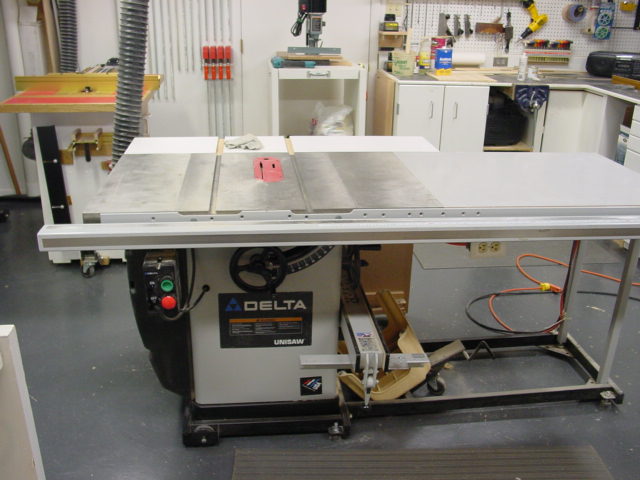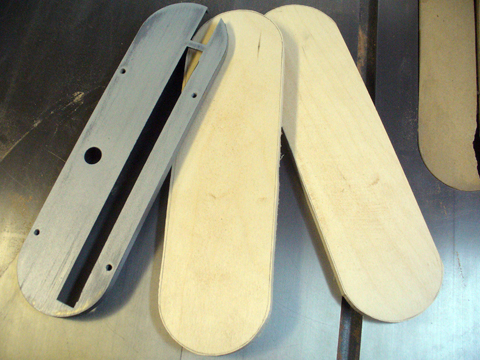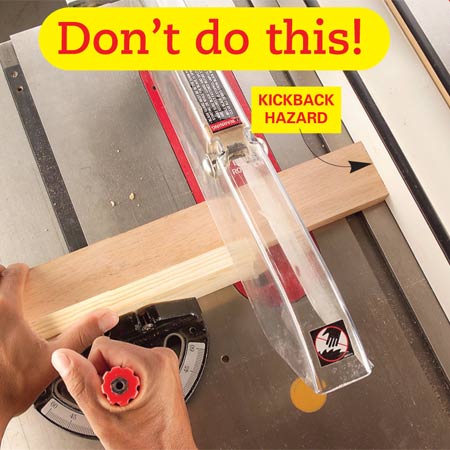There are lots of useful power tools in the shop. The band saw. The router. The thickness planer. The drill press.
But, as far as versatility is concerned, there are few multi-taskers as capable as the table saw.
Rip. Crosscut. Angle cut. Cut joinery. If you can dream it, a well-tuned table saw can get you there.
But, the major concern about this useful tool is safety. A quick visit to the Table Saw Accidents site shows that table saws cause the most injuries of any stationary power saw. A blade with carbide teeth whirring at between 5,000 and 9,000 RPMs can get your attention in a hurry.
Many of the accidents involved contact with the blade or some kind of kickback, but a significant number of injuries occur when an off cut is caught and thrown back toward the operator or the operator reaches across the blade to retrieve an off cut. With the saw blade’s teeth arranged on a circular blade body, it’s easy to see that the the teeth that do the cutting at the front of the blade push the work down to the table. The problem comes in when something contacts the teeth rising out of the back of the table. Should a workpiece his that, it could be sent flying back toward you.
And, I know you know the safety rule about keeping your hands at least three inches away from the blade at all times, but there’s always that moment during repetitive cutting where I find myself reaching across the top of the blade reflexively to knock an off cut away. It’s always a bad idea, and I know I have to remind myself to stop doing that.
But, what about those pesky offcuts? How can you corral them safely to keep them away from the blade and keep them from interfering with your work?
Some of the tips I’ve seen out there include:
Zero Clearance Inserts. These insert plates allow for a very tight opening around the table saw blade, preventing thinner offcuts from falling into the saw’s body. Not only do they prevent these issues, they also allow for cleaner cuts with little tear out where the blade exits the bottom of the work piece. They are very easy to make, so keep a few on hand if you change your blade or for different dado blade widths.
Use your splitter. Splitters and riving knives help to prevent contact with the back side of the saw blade. Working without a splitter could allow the wood you are cutting to do just that. Riving knives, since they raise and lower with the blade, rarely have to be removed. Splitters do have to be removed for non-through cuts. So, if you need to take it off for an operation, be sure to return it when you are done.
Support your crosscut. If you have to do a lot of crosscutting, a crosscut jig can help you get better control. By building a version that straddles the blade, your work will be supported on both sides of the cut. Also, if you build the sled properly, you can clamp a piece of scrap wood as a hold down clamp, holding both the keeper and offcut piece safely in place.
Watch the side space. It’s tempting to use both the miter gauge (to hold the piece at 90 degrees) and the rip fence (as a stop block to cut consistent lengths) to make crosscuts, but that’s a very bad idea. By not allowing enough room for the off cut to fall away, it could pinch between the blade and fence and fly back at you. It’s a great idea to use a stop block clamped to the rip fence as a gauge and setting that gauge behind the point where the blade contacts the wood. This way, once the piece clears the blade, it’s free to fall away.
Support your pieces. The table saw makes quick work of ripping, but you have got to exercise care when doing that. For long pieces, set up an outfeed table slightly lower than the height of the table saw’s top. This way, when the board clears the saw and the weight tips the board toward the outfeed side, you still have support under the board, preventing it from pivoting away from you.
Clear those offcuts. Sure, they seem innocent enough, just sitting there on the left side of the blade. Those little offcut pieces don’t normally cause issues… but they can vibrate into the blade and be flung at you. I’ve seen lots of jigs out there to steer those scraps away from the blade. I’ve seen people try to hook up compressed air systems to blow them away. And, it always seems like such a great idea to push them away from the spinning blade with a stick and keep on cutting. But, so far, the safest way I’ve seen to remove them from the saw is to turn the darned thing off between cuts, wait until the blade comes to a stop and then pull them away.
Needless to say, you should also wear all of the obligatory safety gear, never operate the saw after drinking or on certain prescription drugs and always listen to that little voice in your head. That way, you can spend more time fuming about your offcuts and less time nursing a pretty gruesome injury.





Thumbs up!
I really like your article. These are the things that we should always be thinking about. I have the twin of the saw in the top of the piece but with one addition. I have a shelf under the right side to hold all my safety gear. That way it is right there any time I need it.
All good tips.
Thanks Tom.